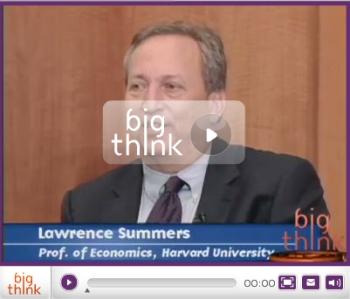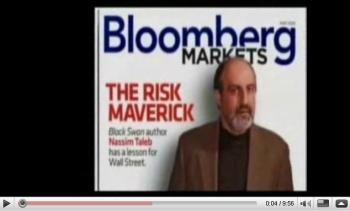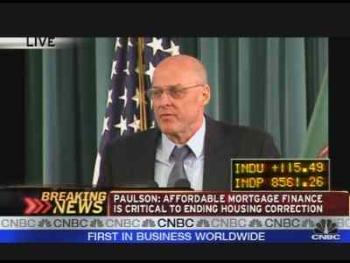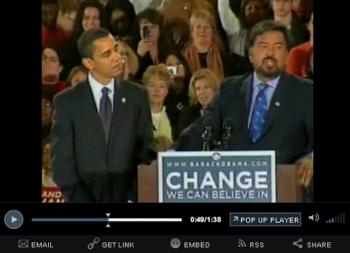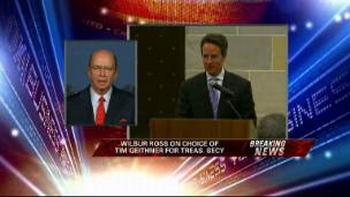Investors Give Thanks for Stock Market Five Day Rally
Stock-Markets / Financial Markets Nov 30, 2008 - 05:12 PM GMT

 The holiday-shortened Thanksgiving week brought investors an additional item to be thankful for when stock markets closed higher for five consecutive trading days - a rare winning streak last accomplished in July 2007. The S&P 500 Index has gained 19.1% since the start of the rally on November 21 and 12.0% on the week, registering the largest weekly gain since 1974.
The holiday-shortened Thanksgiving week brought investors an additional item to be thankful for when stock markets closed higher for five consecutive trading days - a rare winning streak last accomplished in July 2007. The S&P 500 Index has gained 19.1% since the start of the rally on November 21 and 12.0% on the week, registering the largest weekly gain since 1974.
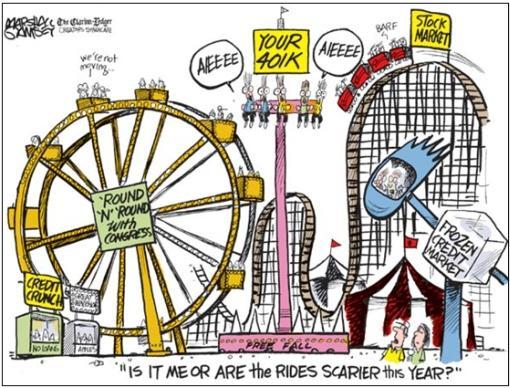
Source: Daryl Cagle
Worrisome economic reports were cast aside by equity bulls, arguing that the bad news had already been priced in. However, US Treasury Note yields were less sanguine and fell to its lowest level on record, pointing to deflation concerns and suggesting that investors remained skeptical about the government's latest moves to help revive the ailing economy. Importantly, US three-month Treasury Bills were trading at a minuscule 0.03%, indicating that liquidity was still being hoarded.
President-elect Obama stressed the need for quick action to expedite an economic recovery and introduced his administration's economic team, including former Federal Reserve Chairman Paul Volcker as head of a new White House Economic Recovery Advisory Board tasked to revive growth in the US. Involving the 81-year Volcker in this way is a smart move by Obama.
A catalyst for last week's stock market recovery was the announcement on Monday of the US government's rescue plan for Citigroup (C), including a direct $20 billion investment and $306 billion in asset guarantees.
With credit markets still not thawing after the introduction of various central bank liquidity facilities and capital injections, the Fed on Tuesday unveiled further steps aimed at lowering borrowing costs for consumers and home buyers. The Fed will buy $100 billion of debt from Fannie Mae (FNM), Freddie Mac (FRE) and the Federal Home Loan Banks, and also purchase up to $500 billion of mortgage paper backed by the agencies. The Fed will furthermore lend $200 million to holders of key asset-backed securities regarding small business and consumer (auto, student, credit card) loans.
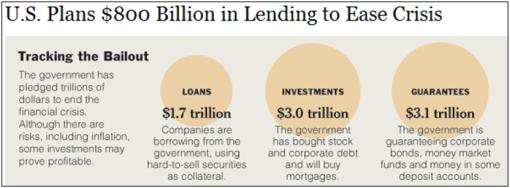
Source: The New York Times , November 25, 2008.
Commenting on the US government's bailout actions and quoting from the Jerusalem Post , Bill King said: “There is one last thing that Hank, Ben and Geithner can do: ‘The country's chief rabbis are calling for a mass prayer rally on Thursday in the hope that heavenly intervention will stem the global financial crisis.'”
Next, a tag cloud of the text of the dozens of articles I have devoured over the past week. This is a way of visualizing word frequencies at a glance. The usual suspects feature prominently, with “gold” attracting increasing attention.

Has the stock market reached a secular low or is it just bouncing off oversold levels? According to Fox Business Network , legendary investor Jim Rogers said: “We're ready for a rally. I mean, the market in October and earlier this month has had a huge selling climax. I covered a lot of my shorts. Who knows if I'm right or not. But I expect the market to rally for some time. It may rally into next year. But … this is a false rally. It's not going to be great. It's not the end of the problems in America and it's not the end of the bear market.”
A positive for the bulls is that the period post Thanksgiving through the end of the year has usually been a strong time for stocks. According to Jeffrey Hirsch ( Stock Trader's Almanac ), “December is normally a banner month for stocks, ranking second [on the monthly calendar] for the Dow and S&P 500 and third for the Nasdaq.”
Should the bullish seasonal tendencies hold true on this occasion, possible first targets are the November 4 highs of 9,625 for the Dow (current level 8,829) and 1,006 for the S&P 500 (current level 896). This will also result in both indices clearing their 50-day moving averages.
“There is no doubt that time is needed for volatility to settle down before many will have the confidence to return to investing, but if one looks beyond the end of the year, 2009 will almost certainly be a better year for investors than 2008,” said David Fuller ( Fullermoney ) from London.
Although there is not yet conclusive evidence that we are leaving the corpse of the bear behind (especially with Q4 earnings disasters looming in January), it would appear that the nascent rally could have more steam left. (Also read my recent posts “ Is the tide turning for stocks? ” and “ Does the stock market rally have legs? “)
I am about to hit the road again - traveling to New York City - and blog posts will therefore take a back seat for the next week as I explore the Big Apple and meet with friends, blog readers and business associates in the cold weather and depressed economic climate.
Before highlighting some thought-provoking news items and quotes from market commentators, let's briefly review the financial markets' movements on the basis of economic statistics and a performance round-up.
Economy
“Global business sentiment is as dark as it has ever been, although the free fall in confidence may be over,” said the latest Survey of Business Confidence of the World conducted by Moody's Economy.com . “Pessimism is pervasive across the entire globe, with the only distinction being that Asian businesses are somewhat less nervous than elsewhere. Pricing pressures are falling rapidly, although they are not yet consistent with outright deflation.” The global economy is suffering a severe recession according to the results of the business confidence survey.
Economic indicators released in the US during the past week all pointed to a deepening recession. According to Briefing.com , Q3 GDP was revised down to -0.5% from -0.3%, durable orders slumped by 6.2%, existing home sales fell by 3.1%, new home sales dropped by 5.3%, personal spending declined by 1.0%, and weekly initial claims, while improved from the prior week, continued to register a reading above 500,000.
The Chicago Purchasing Managers Index came in at 33.8, the weakest number since the serious recession of 1982. “The national number due next Monday will be just as ugly, as durable goods were down far more than expected, by a negative 6.2%,” added John Mauldin ( Thoughts from the Frontline ).

Commenting on the outlook for interest rates, Asha Bangalore ( Northern Trust ) said: “Going forward, real GDP is expected to show a decline that is upward of 4.0% in the fourth quarter of 2008. The Fed is widely expected to lower the Federal funds rate to 0.5% on December 16.” However, the Fed's quantitative easing approach to monetary policy now seems to be targeting the quantity of money rather than its price.
Elsewhere in the world, the People's Bank of China (PBoC) slashed its benchmark interest rates by 108 basis points and also lowered the reserve requirement for banks. This move indicates that China will be joining the rest of the world in a marked economic slowdown.
In the upcoming week, the European Central Bank and the Bank of England are expected to reduce interest rates by 50 and 75 basis points respectively in the light of a deteriorating economic outlook.
Week's economic reports
Click here for the week's economy in pictures, courtesy of Jake of EconomPic Data .
Date |
Time (ET) |
Statistic |
For |
Actual |
Briefing Forecast |
Market Expects |
Prior |
| Nov 24 | 10:00 AM | Existing Home Sales | Oct | 4.98M | 5.07M | 5.05M | 5.14M |
| Nov 25 | 8:30 AM | Chain Deflator-Prel. | Q3 | 4.2% | 4.2% | 4.2% | 4.2% |
| Nov 25 | 8:30 AM | GDP -Prel. | Q3 | -0.5% | -0.3% | -0.5% | -0.3% |
| Nov 25 | 10:00 AM | Consumer Confidence | Nov | 44.9 | 40.0 | 39.5 | 38.0 |
| Nov 26 | 8:30 AM | Durable Orders | Oct | -6.2% | -2.2% | -2.5% | -0.2% |
| Nov 26 | 8:30 AM | Initial Claims | 11/22 | 529K | 535K | 537K | 543K |
| Nov 26 | 8:30 AM | Personal Income | Oct | 0.3% | 0.2% | 0.1% | 0.1% |
| Nov 26 | 8:30 AM | Personal Spending | Oct | -1.0% | -0.6% | -0.7% | -0.3% |
| Nov 26 | 9:45 AM | Chicago PMI | Nov | 33.8 | 39.5 | 38.5 | 37.8 |
| Nov 26 | 10:00 AM | Mich Sentiment-Rev. | Nov | 55.3 | 58.5 | 58.0 | 57.9 |
| Nov 26 | 10:00 AM | New Home Sales | Oct | 433K | 450K | 450K | 457K |
| Nov 28 | 9:45 AM | Chicago PMI | Nov | - | NA | NA | NA |
Source: Yahoo Finance , November 28, 2008.
In addition to the Fed releasing its Beige Book (Wednesday) and interest rate decisions by the European Central Bank and the Bank of England (Thursday), next week's US economic highlights, courtesy of Northern Trust , include the following:
1. ISM Manufacturing Survey ( December 1): The consensus for the manufacturing ISM composite index is 38.4 versus 38.9 in October.
2. Employment situation ( December 5): Payroll employment in November is predicted to have dropped by 300,000 after 240,000 jobs were lost in October. The unemployment rate is expected to move up two notches to 6.7%. Consensus : Payrolls: -300,000 versus -240,000 in October, unemployment rate: 6.7% versus 6.5% in October.
3. Other reports : Construction spending (December 1), auto sales (December 2), ISM non-manufacturing, productivity and costs (December 3), and factory orders (December 4).
Markets
The performance chart obtained from the Wall Street Journal Online shows how different global markets performed during the past week.
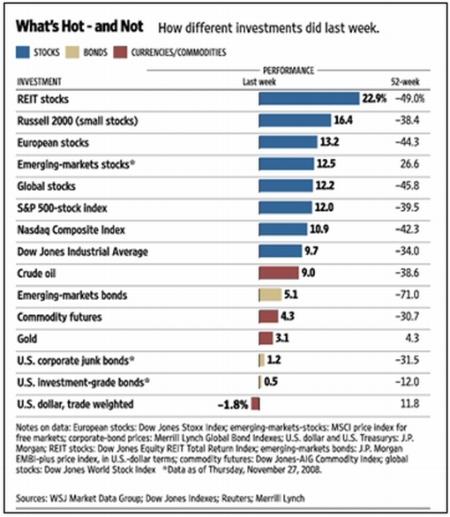
Source: Wall Street Journal Online , November 28, 2008.
Equities
Global stock markets surged during the past week on the back of a combination of bargain-hunting and short covering, albeit on light trading volume as a result of the Thanksgiving holiday in the US.
Both mature and emerging markets shared handsomely in the rally that commenced on November 21, as shown by the subsequent gains of the MSCI World Index (+15.7%) and the MSCI Emerging Markets Index (+13.5%). Notwithstanding the improvement, these indices are still down by 43.8% and 57.7% respectively for the year to date.
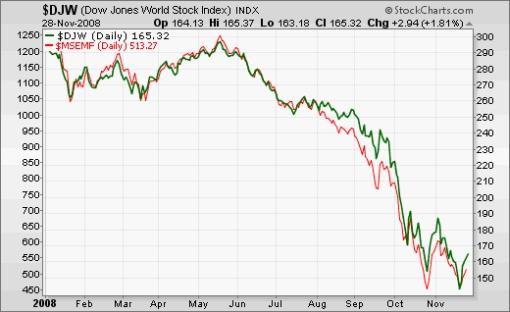
Click here or on the thumbnail below for a (delightfully green) market map, obtained from Finviz , providing a quick overview of last week's performances of global stock markets (as reflected by the movements of ADR stocks).
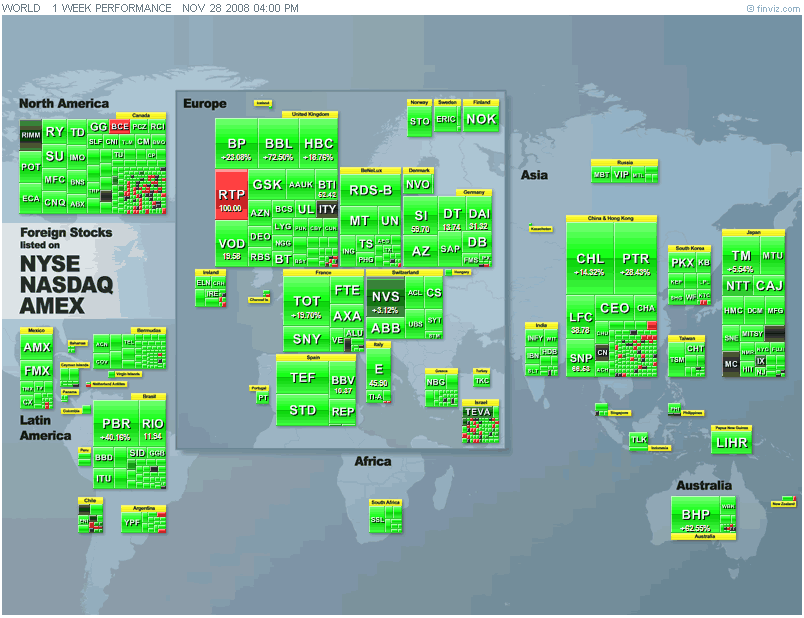
The US stock markets all rallied sharply over the week as shown by the major index movements: Dow Jones Industrial Index +9.7 (YTD -33.5%), S&P 500 Index +12.0% (YTD -39.0%), Nasdaq Composite Index +10.9% (YTD ‑42.1%) and Russell 2000 Index +16.4% (YTD -38.2%).
The bar chart below, also from Finviz.com , shows the US sector performances over the week, and specifically how strongly financials and materials have recovered.
As far as industry groups are concerned, the automobile manufacturing group (+82%) was the top performer for the week. General Motors Corp (GM) and Ford Motor (F) rose by 71% and 88% respectively on the expectation that auto makers will receive a government bailout.
The homebuilding group (+59%) was the second-best performer on the prospect that the US government's latest rescue package will result in lower mortgage rates and mortgage credit becoming more readily available.
Seven of the ten underperforming groups were from the three top-performing sectors for the year to date - consumer staples, health care and utilities. These sectors, which typically outperform in a declining market, tend to lag in a rising market such as the one experienced last week.
Interestingly, the percentage of S&P 500 stocks trading above their 50-day moving averages has increased from almost zero in October to 19% on Friday - a promising improvement.
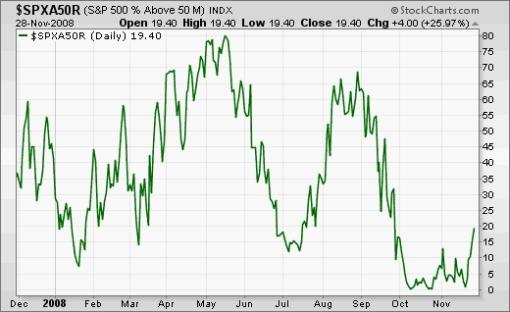
I am often asked by readers about Richard Russell's ( Dow Theory Letters ) latest views. This is what the old-timer said on Friday: “The big question now is whether the tide is in the early process of turning bullish. If so, we should be seeing a series of constructive, even bullish days. … I wonder whether my more aggressive subscribers shouldn't jump the gun and maybe buy the Diamonds (DIA) at the opening on Monday.”
Fixed-interest instruments
The ten-year US Treasury Note yield declined to its lowest level since record-keeping began in 1958, closing 25 basis points lower on the week at 2.93% after falling as low as 2.82% earlier on Friday.
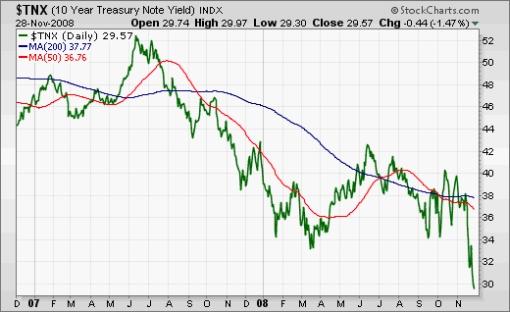
In addition to economic and deflation worries, Treasuries also benefited from lower mortgage rates as a result of the Fed's decision to buy GSE-insured mortgage paper. The 30-year fixed mortgage rate dropped by 25 basis points to 5.84%.
“The lower mortgage rates threaten to trigger a wave of mortgage refinancing, the prospect of which has pushed investors to hedge that risk by buying ten-year Treasury debt, a benchmark for mortgage rates,” reported the Financial Times “.
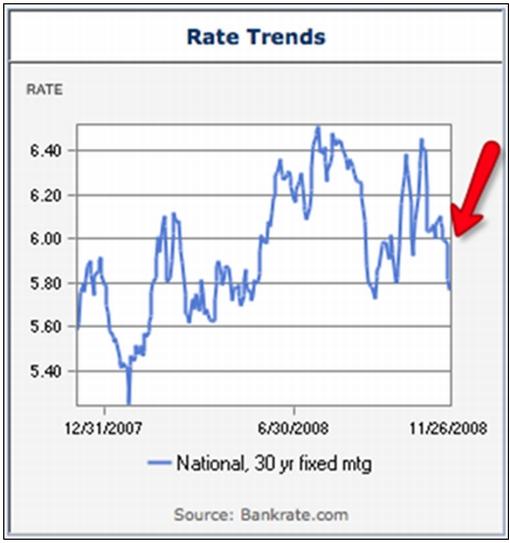
The UK ten-year Gilt yield dropped by 9 basis points to 3.78% and the German ten-year Bund yield fell by 12 basis points to 3.26%. Emerging-market bonds also performed well, with the JPMorgan EMBI Global Index gaining 5.1% during the week.
Although some progress has been made as a result of central banks' liquidity facilities and capital injections, the credit markets are not yet thawing (see my “ Credit Crisis Watch ” of November 28). The TED and LIBOR-OIS spreads have tightened since the panic levels of October 10, whereas the CDX and iTraxx indices have also shown some improvement over the past few days. However, US Treasury Bills and high-yield spreads are still at crisis levels.
Currencies
Most currencies rebounded against the US dollar during the past week as the greenback came under pressure as a result the Fed's new measures to unclog the credit markets.
Over the week the US dollar lost ground against the euro (-0.8%), the British pound (-3.1%), the Swiss franc (-0.8%), the Japanese yen (-0.3%), the Canadian dollar (-2.4%), the Australian dollar (-3.7%) and the New Zealand dollar (-4.3).
The US currency also fell against emerging-market currencies such as the Brazilian real (‑7.7%), the Turkish lira (-6.0%) and the South African rand (-4.1%).
Interestingly, the Chinese renminbi (+6.9%) is the only major emerging-market currency that has appreciated against the US dollar over the year to date.

Commodities
The Reuters/Jeffries CRB Index (+4.7%) closed higher by the end of the week - only its fifth positive week since commodities peaked early in July. Arguing against a more lasting reversal of fortune for commodities, the Baltic Dry Index - a benchmark for shipping major raw materials, including coal, iron ore and grain, and generally an excellent barometer of economic activity - declined by 14.5% to its lowest level since 1987.
The graph below shows the movements of various commodities over the past week, indicating an improvement across the whole complex as a weak US dollar pushed prices higher.
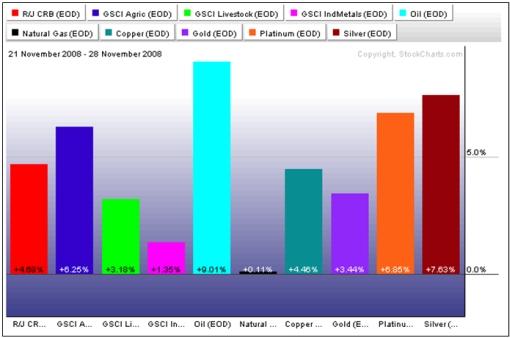
Gold bullion (+3.4%) remained in favor with investors as a result of a solid supply/demand situation, store-of-value considerations and a positive-looking chart (see below). A research report from Citigroup, as reported by the Telegraph , said gold could rise above $2,000 within two years. Platinum (+6.9%) and silver (+7.6%) - massive underperformers since March - were also in demand last week.
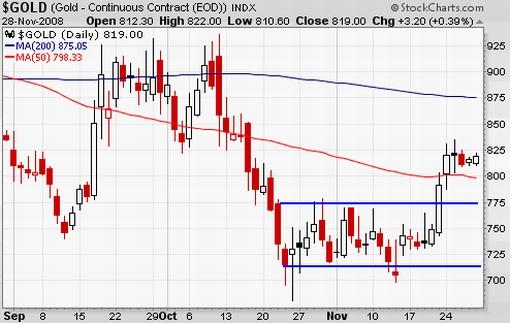
In the aftermath of Thanksgiving, may I remind you of the following old stock market adage: “The bears have Thanksgiving and the bulls have Christmas.” Let's hope for an early Christmas! Meanwhile, the news items and words from the investment wise below will hopefully assist in steering our portfolios on a profitable course.
That's the way it looks from Cape Town.
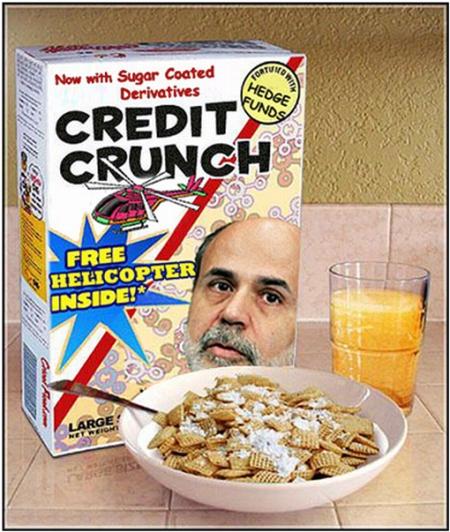
Hat tip: Mish (via Live Leak )
Big Think: Beyond the crisis - conversation with Larry Summers, George Soros and Robert Merton
Source: Big Think , November 2008.
PBS News Hour: Taleb, the risk maverick
“Interview with Nassim Nicholas Taleb, famous economist and author of ‚The Black Swan' and Dr. Mandelbrot, professor of Mathematics. Both say that the present economy is more serious than the Great Depression, and the economy during the American Revolution.”
Source: PBS News Hour (via YouTube ), October 22, 2008.
IDD magazine: John Bogle - great expectations
“John Bogle founded the Vanguard Mutual Fund Group in 1974. He served as its chairman and chief executive until 1996 and remained on as senior chairman until 2000.
“Recently, he wrote ‘Enough: True Measures of Money, Business and Life', which was published by John Wylie & Sons.
“To call it a business book - a how-to or memoir - would be too simplistic. In fact, it is far from the typical business book because it offers some interesting life lessons on dealing with people, especially clients and customers.
“Bogle spoke with IDD last week, offering his thoughts on long-term investing and how it may come back - as opposed to rapid-fire maneuvers in and out of a company's shares - and his thoughts on PE fund managers as well as hedge funds. Not surprisingly, they are not positive.
“As Bogle sees it ‘we have made Wall Street too much of a casino. It is totally dominated by speculation … we are engaged in an orgy of speculation the likes of which has never been seen in the history of this country.'
“His rule of thumb for investors: your bond position should equal your age. ‘I'm about 80% bonds. I started 65% about 15 years ago,' says Bogle.
“Following are excerpts from the interview:
“IDD: How do you think the credit crisis will play out?
“BOGLE: The market can't bail itself out of this mess. Wall Street has a lot to answer for to Main Street and yet Main Street, which is really where the tax base is, is going to have to bail out Wall Street for Wall Street's errors. And that is, of course, a tragedy - an economic tragedy. But I am persuaded because I respect people like Larry Summers, I certainly respect Ben Bernanke. I am not so sure about Hank Paulson. I suppose I respect him in a way, but his issue is that he is an investment banker. So it should come as no surprise to anybody that he looks at these things from an investment banker's perspective. How else can he look at them? It [the bailout] has to happen. I think it is too bad it has to happen, but I think we ought to get ready for building a better financial system, which means building a smaller financial system because what is going on Wall Street is a casino and our croupier has raked too much off of the table before we get paid.
“IDD: When you say our financial system gets smaller, what do you mean by that?
“BOGLE: Revenues will be less for a whole bunch of reasons. First, they are never going to be allowed - with the government being part owners of them - to have 35-to-1 leverage. Number two, we're going to have better disclosure about what is on that balance sheet. When you think about it, if you are leveraged 35 to 1 and all your assets are Treasury bills I don't see that as much of a problem. The problem is that none of them are Treasury bills. They are toxic mortgages and we need much better disclosure of that. The third thing is that they are going to have to be content with less revenues.”
Source: Aleksandrs Rozens, IDD magazine , November 17, 2008.
Spiegel Online: George Soros - “The economy fell off the cliff”
“George Soros, 78, has made billions as a hedge-fund manager and investor. Spiegel spoke with him about the current financial crisis, how he expects President-elect Barack Obama to respond to the economic disaster and the responsibilities borne by speculators.
“SPIEGEL: Mr. Soros, in spite of massive interventions by governments and federal banks the financial crisis is getting worse. The stock markets are in free fall, millions of people could lose their jobs. More and more companies are in trouble, from General Motors in Detroit to BASF in Ludwigshafen. Have you ever seen anything like it?
“Soros: Never. I find the present situation dramatic and overwhelming. In my latest book ‘The New Paradigm for Financial Markets: The Credit Crisis of 2008′ I predicted the worst financial crisis since the 1930s. But to tell you the truth: I did not actually anticipate that it would get as bad as it did. It has gone beyond my wildest imagination.
“‘I find the present situation dramatic and overwhelming.'
“SPIEGEL: What are your fears for the coming months?
“Soros: I think that the dark comes before dawn. The financial markets are under great pressure because of the lack of leadership during the transition period. In the next two months, the markets will experience maximum pressure. Then we will see some initiatives from the Obama administration. How long the crisis lasts will depend on the success of these measures.
“SPIEGEL: The markets don't seem to have much confidence in the new president - in stark contrast to the enthusiasm in the population. Since Election Day on November 4, stocks have fallen by almost 20%.
“Soros: I have great hopes for Barack Obama. But at the time of the election the financial community had not yet fully grasped the magnitude of the economic decline. They did not anticipate that the default of Lehman Brothers would cause cardiac arrest in the markets. The economy fell off the cliff, you begin to see mangled bodies lying at the bottom.”
Source: Spiegel Online , November 24, 2008.
The New York Times: Paulson on new moves in rescue plan
“CNBC coverage of opening remarks by Treasury Secretary Henry Paulson in a news conference describing new steps to ease credit markets.”
Click here for the article.
Source: The New York Times , November 25, 2008.
Asha Bangalore (Northern Trust): Fed institutes two more programs to support working of financial markets
“The Federal Reserve announced the creation of Term Asset-Backed Securities Loan Facility (TALF) in conjunction with the Treasury. The program that will involve the Federal Reserve Bank of New York lending up to $200 billion to holders of AAA-rated asset backed securities ‘backed by newly and recently originated consumer and small business loans'.
“The US Treasury Department, under the Emergency Economic Stabilization Act of 2008, will provide $20 billion of credit protection to the Federal Reserve Bank of New York for these non-recourse loans. The loans will involve a haircut based on the asset class and there is fee for participation.
“This new program is designed to address problems in the auto, student, credit card, and Small Business Administration guaranteed loans. Loans to consumers have become scarce because securitization of consumer loans has come to a standstill. Funding these loans should result in a resumption of the working of these markets. A date and details are being worked out.
“The Fed also announced it will start purchasing Government Sponsored Enterprises (GSE) - Fannie Mae, Freddie Mac, and Federal Home Loan Banks - this week. Spreads of these securities vis-à-vis Treasury securities have widened sharply in recent days. Purchases of $100 billion in GSE direct obligations and $500 of Mortgage Backed Securities will be undertaken under this program. The objective of this action is to increase the availability of credit for purchases of homes.
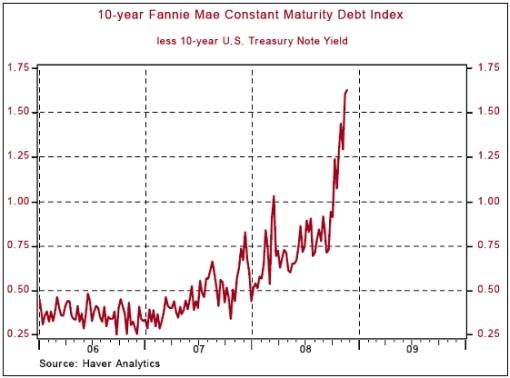
“These actions will raise reserves in the banking system and increase the size of the Fed's balance sheet. The sum of today's action is $800 billion. The Fed's balance sheet as of November 25, 2008 had ballooned to 2.19 trillion from $995.57 billion as of September 17, 2008.”
Source: Asha Bangalore, Northern Trust - Daily Global Commentary , November 25, 2008.
Bloomberg: US pledges top $7.7 trillion to ease frozen credit
“The US government is prepared to provide more than $7.76 trillion on behalf of American taxpayers after guaranteeing $306 billion of Citigroup debt yesterday. The pledges, amounting to half the value of everything produced in the nation last year, are intended to rescue the financial system after the credit markets seized up 15 months ago.
“The unprecedented pledge of funds includes $3.18 trillion already tapped by financial institutions in the biggest response to an economic emergency since the New Deal of the 1930s, according to data compiled by Bloomberg. The commitment dwarfs the plan approved by lawmakers, the Treasury Department's $700 billion Troubled Asset Relief Program. Federal Reserve lending last week was 1,900 times the weekly average for the three years before the crisis.
“When Congress approved the TARP on October 3, Fed Chairman Ben Bernanke and Treasury Secretary Henry Paulson acknowledged the need for transparency and oversight. Now, as regulators commit far more money while refusing to disclose loan recipients or reveal the collateral they are taking in return, some Congress members are calling for the Fed to be reined in.
“Bloomberg News tabulated data from the Fed, Treasury and Federal Deposit Insurance Corp. and interviewed regulatory officials, economists and academic researchers to gauge the full extent of the government's rescue effort.
“The bailout includes a Fed program to buy as much as $2.4 trillion in short-term notes, called commercial paper, that companies use to pay bills, begun October 27, and $1.4 trillion from the FDIC to guarantee bank-to-bank loans, started October 14.
“William Poole, former president of the Federal Reserve Bank of St. Louis, said the two programs are unlikely to lose money. The bigger risk comes from rescuing companies perceived as ‘too big to fail', he said.”
Source: Mark Pittman and Bob Ivry, Bloomberg , November 24, 2008.
Barry Ritholtz (The Big Picture): Big bailouts, bigger bucks
“Whenever I discussed the current bailout situation with people, I find they have a hard time comprehending the actual numbers involved. That became a problem while doing the research for the Bailout Nation book . I needed some way to put this into proper historical perspective.
“If we add in the Citi bailout, the total cost now exceeds $4.6165 trillion. People have a hard time conceptualizing very large numbers, so let's give this some context. The current Credit Crisis bailout is now the largest outlay in American history.
“Jim Bianco of Bianco Research crunched the inflation adjusted numbers. The bailout has cost more than all of these big budget government expenditures combined:
• Marshall Plan : Cost: $12.7 billion, Inflation Adjusted Cost: $115.3 billion
• Louisiana Purchase : Cost: $15 million, Inflation Adjusted Cost: $217 billion
• Race to the Moon : Cost: $36.4 billion, Inflation Adjusted Cost: $237 billion
• S&L Crisis : Cost: $153 billion, Inflation Adjusted Cost: $256 billion
• Korean War : Cost: $54 billion, Inflation Adjusted Cost: $454 billion
• The New Deal : Cost: $32 billion (Est), Inflation Adjusted Cost: $500 billion (Est)
• Invasion of Iraq : Cost: $551b, Inflation Adjusted Cost: $597 billion
• ietnam War : Cost: $111 billion, Inflation Adjusted Cost: $698 billion
• NASA : Cost: $416.7 billion, Inflation Adjusted Cost: $851.2 billion
TOTAL : $3.92 trillion
“That is $686 billion less than the cost of the credit crisis thus far. The only single American event in history that even comes close to matching the cost of the credit crisis is World War II: Original Cost: $288 billion, Inflation Adjusted Cost: $3.6 trillion. The $4.6165 trillion dollars committed so far is about a trillion dollars ($979 billion dollars) greater than the entire cost of World War II borne by the United States: $3.6 trillion, adjusted for inflation (original cost was $288 billion).
“I estimate that by the time we get through 2010, the final bill may scale up to as much as $10 trillion dollars …”
Source: Barry Ritholtz, The Big Picture , November 25, 2008.
Casey's Charts: Budgeting your future
“The October statement of the US Treasury Department revealed that the federal deficit has reached the largest level on record. Over the last twelve months, the US government spent $618 billion dollars more than it was able to collect.
“The deficit is already enormous and with all signs pointing towards even greater government spending, the implications are astounding. Casey Research Chief Economist Bud Conrad predicts that next year's budget deficit will be closer to the tune of $1.5 trillion!”

Source: Casey's Charts , November 21, 2008.
Breitbart: IMF chief economist - worst of financial crisis yet to come
“The IMF's chief economist has warned that the global financial crisis is set to worsen and that the situation will not improve until 2010, a report said Saturday. Olivier Blanchard also warned that the institution does not have the funds to solve every economic problem.
“‘The worst is yet to come,' Blanchard said in an interview with the Finanz und Wirtschaft newspaper, adding that ‘a lot of time is needed before the situation becomes normal.'
“He said economic growth would not kick in until 2010 and it will take another year before the global financial situation became normal again.
“The International Monetary Fund on Friday promised to help Latvia deal with its economic crisis after it assisted Iceland, Hungary, Ukraine, Serbia and Pakistan.
“But Blanchard said the IMF was not able to solve all financial issues, in particular problems of liquidity.
“Withdrawals of capital leading to problems of liquidity ‘can be so significant that the IMF alone cannot counter them', he said, adding that massive withdrawals of investments from emerging countries could represent ‘hundreds of billions of dollars. We do not have this money. We never had it,' he said.”
Source: Breitbart , November 22, 2008.
The Wall Street Journal: Obama names his economic team
“Looking to hit the ground running on January 20 and restore confidence, President-elect Barack Obama seals up his economic appointments.”
Source: The Wall Street Journal , November 24, 2008.
Bloomberg: Obama names Volker to head panel on reviving economy
“President-elect Barack Obama named former Federal Reserve Chairman Paul Volcker to head a new White House economic board that will propose ways to revive growth as the US grapples with an ‘economic crisis of historic proportions'.
“‘At this defining moment for our nation, the old ways of thinking and acting just won't do,' Obama said at a news conference in Chicago, his third in as many days.
“Volcker, 81, will be chairman of the President's Economic Recovery Advisory Board. The panel's top staff official will be Austan Goolsbee, a University of Chicago economist who will also be a member of the president's Council of Economic Advisers.
“The panel, which will include experts from outside government, will meet about once a month and periodically brief Obama with advice on how to shore up financial markets. Volcker's position will be part-time.
“‘Sometimes policymaking in Washington can become too insular,' Obama said. ‘The walls of the echo chamber can sometimes keep out fresh voices and new ways of thinking, and those who serve in Washington don't always have a ground-level sense of which programs and policies are working.'
“Volcker, who throttled the economy to crush inflation in the 1980s, was an adviser to Obama during the presidential campaign. He was a candidate for Treasury secretary, a job that went to Federal Reserve Bank of New York President Timothy Geithner.
“‘He is one of the most independent-thinking guys you could find and brings massive reputation,' Ethan Harris, co-head of US economic research at Barclays Capital in New York, said before today's announcement.”
Source: Kim Chipman and Catherine Dodge, Bloomberg , November 26, 2008.
ABC News: Summers to be top white house economic adviser at NEC
“ABC News has learned that President-elect Obama has decided to name former Treasury Secretary Larry Summers the director of the National Economic Council, essentially the president's senior economic adviser.
“Part of the Executive Office of the President, the NEC was created for the purpose of advising the President on matters related to US and global economic policy. The NEC has four functions, by executive order: ensuring that programs and policy decisions are consistent with the President's economic goals, monitoring the implementation of the President's economic policy agenda, coordinating policy-making for domestic and international economic issues, and coordinating economic policy advice for the President.
“Summers was the 71st Secretary of the Treasury, serving from July 1999 until the end of the Clinton administration in January 2001, having previously served as undersecretary for international affairs and deputy secretary of the Treasury. He also served as chief economist of the World Bank.
“At the Treasury Department in the 1990s, Summers worked closely with Tim Geithner, the man Obama intends to nominate to be the next Secretary of the Treasury. The two are said to have an excellent working relationship.
“Some Democrats say that Obama and Summers have an understanding that when current Federal Reserve Chairman Ben Bernanke's term expires in 2010, Obama will name Summers to take his place.”
Source: ABC News , November 22, 2008.
Fox Business: Wilbur Ross on the next Treasury Secretary
Source: Fox Business , November 21, 2008.
Did you enjoy this post? If so, click here to subscribe to updates to Investment Postcards from Cape Town by e-mail.
By Dr Prieur du Plessis
Dr Prieur du Plessis is an investment professional with 25 years' experience in investment research and portfolio management.
More than 1200 of his articles on investment-related topics have been published in various regular newspaper, journal and Internet columns (including his blog, Investment Postcards from Cape Town : www.investmentpostcards.com ). He has also published a book, Financial Basics: Investment.
Prieur is chairman and principal shareholder of South African-based Plexus Asset Management , which he founded in 1995. The group conducts investment management, investment consulting, private equity and real estate activities in South Africa and other African countries.
Plexus is the South African partner of John Mauldin , Dallas-based author of the popular Thoughts from the Frontline newsletter, and also has an exclusive licensing agreement with California-based Research Affiliates for managing and distributing its enhanced Fundamental Index™ methodology in the Pan-African area.
Prieur is 53 years old and live with his wife, television producer and presenter Isabel Verwey, and two children in Cape Town , South Africa . His leisure activities include long-distance running, traveling, reading and motor-cycling.
Copyright © 2008 by Prieur du Plessis - All rights reserved.
Disclaimer: The above is a matter of opinion and is not intended as investment advice. Information and analysis above are derived from sources and utilizing methods believed reliable, but we cannot accept responsibility for any trading losses you may incur as a result of this analysis. Do your own due diligence.
Prieur du Plessis Archive |
© 2005-2022 http://www.MarketOracle.co.uk - The Market Oracle is a FREE Daily Financial Markets Analysis & Forecasting online publication.




